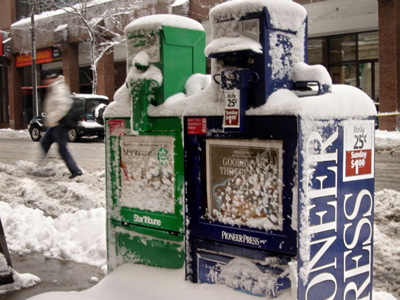
Listening and reading about the state of the newspaper industry these days is a lot like listening and reading about global warming: I wish things weren’t so bad, but what exactly do you expect me — an averge Joe — to do about it that’s going to make a difference before the last ice cap melts or dead-tree edition is printed? The more I learn about both, the more I am filled with hopelessness.
Here in Minnesota this week, the fires were stoked by the leaking of a memo from Star Tribune publisher Chris Harte to his staff, in which he announced the hiring of a consulting firm — Restructuring Associates — to fix what is clearly a basket case.
As a result of rapidly declining revenue – and expenses that haven’t been cut anywhere nearly as fast – our operating cash flow has declined dramatically since 2000. Operating cash flow, which is the cash we have left after paying cash expenses, and which we then use to invest in everything from new equipment and computers to new products, and to pay our debt, has declined 50 percent in just the past two years and more than that since 2000.
Two former newspaper vets have been mostly responsible for analyzing the situation.
Brian Lambert, the former media critic of the Pioneer Press, the Rake and now Minneapolis – St. Paul magazine took a stab at some of the numbers:
Rumors continue to burble that Avista will attempt to unload its misbegotten Minnesota newspaper venture very soon, and a contract that effectively castrates its unions is viewed as critical to properly “staging” the place for a new buyer. More to the point, no buyer is going to pay anything close to $530 million they paid. If Avista were able to sell today for something in the low $300 million range, it’d be a miracle offer they would grab and cash before the buyer sobered up.
And David Brauer at MinnPost dug up what he could on Restructuring Associates (who, for the record, did not respond to my attempts for comment).
RAI doesn’t turn cash-hungry owners into puppy dogs, but they can at least avoid misunderstandings and needless distrust. It’s clear the Strib can use the help; Harte didn’t bother to call in union leaders before announcing the RAI hire or the bombshell numbers.
Editorially, the Star Tribune tried to shift focus to a “hyper-local” newspaper, a philosophy that only put it in an even more competitive situation with its new-media rivals.
Of course, it isn’t just the Star Tribune that’s hemorrhaging, and it isn’t just the Twin Cities that are heading for a one-newspaper-town status. Just in the last 24 hours, the Boston Globe seems poised for a big cutback, layoffs are underway at the Chicago Sun-Times, the situation in Philadelphia turned dire, and the week started with the Los Angeles Times firing its editor because he refused to make further cuts in journalism to satisfy the new owners.
Today, a Ball State professor is out with a study showing the reporters who are left are burned out and — why this is news, I don’t know — cynical.
When the journalists were asked if they had intentions to leave newspaper journalism, 25.7 percent answered ‘yes’ and 36.2 percent answered ‘don’t know,’” the study states. “…Further examination reveals that 31 percent of young journalists (34 and younger) expressed intentions to leave the profession, and 43.5 percent answered ‘don’t know.’”
Former newspaper exec Alan Mutter got the reportorial hackles up a couple of days ago when he spoke up for the bosses…
Like Chris and Avista, Brian Tierney (plus his investors) and Tribune’s Sam Zell have put hundreds of millions of their own dollars at risk to try to save a few newspapers at the most perilous time in the history of the industry.
And there we are; lots of energy expended to tell us the glacier is melting, but a situation so dire that the average person can do little to reverse course. But what if the real story here is outside the newsrooms, nobody cares?
